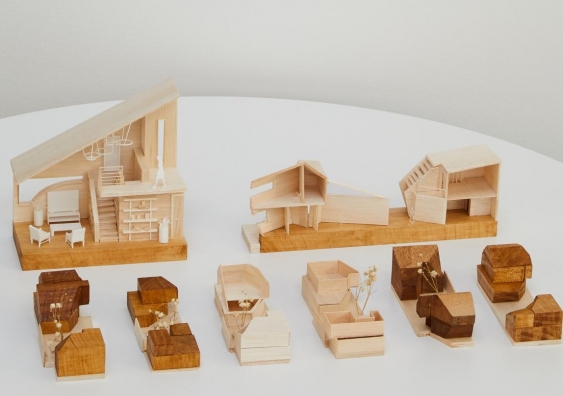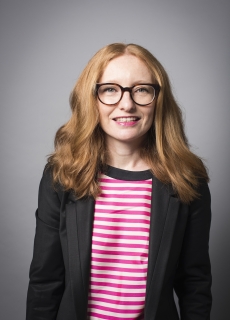Luminocity curator offers global vision for young designers
This year’s Luminocity exhibition showcases the design process behind everything from toothbrushes to skyscrapers, says Dr Nicole Gardner.
This year’s Luminocity exhibition showcases the design process behind everything from toothbrushes to skyscrapers, says Dr Nicole Gardner.

Ben Knight
UNSW Media & Content
+61 2 9385 8107
b.knight@unsw.edu.au
Computational Design lecturer Dr Nicole Gardner was raised on a South Australian farm but was always fascinated by big cities and house designs.
“As a kid, I used to look at real estate floor plans, and I was just intrigued by the arrangement of space. I was also pretty sure I could do it better,” she says.
After graduating from university in Adelaide with a Bachelor of Architecture, she spent the next 15 years as an architect practising around the world. She has worked on a range of projects, including individual and multi-scale residential, education and institutional projects, as well as the London Underground.
She is now a Computational Design lecturer at UNSW Built Environment where she is curating the Luminocity exhibition, the annual showcase of work by undergraduate students which starts on August 27.
Projects from architecture, interior architecture, city planning, computational design, landscape architecture, industrial design, construction and project management will be on display.
“You rarely get the scale of design represented in one place the way that Luminocity does, moving from design models of toothbrushes to bicycle racks, to housing, to skyscrapers, and all the way to the design of new public squares and the urban realm.”
This year, the exhibition has a renewed focus on the design process and in particular the role of model-making. The exhibition will showcase the diverse range of design skills – from hand-drawing, physical model-making and prototyping, to data-rich 3D modelling, coding, digital fabrication, and immersive forms of mixed and virtual realities – that are engaged in the design and construction of the built environment.
“There’s a tangibility associated with physical models, and these models demonstrate how digital fabrication technologies are being used by a range of design students in their courses,” she says. “Quite a few of the projects feature multiple iterations of the model, to demonstrate the process, different scales of design, and also various stages of thinking. The final model looks finished and perfect, but there’s often a long process that takes place to get to that point.”
It was Dr Gardner’s work on major public transport projects, including the King’s Cross Underground Station Redevelopment in London, and as a Senior Architect with Arup in Sydney, designing concepts for the proposed Sydney Metro, that led her to the neighbouring field of computational design.

Dr Nicole Gardner.
“We were using virtual reality and 3D modelling to understand station environments, to think about them from the perspective of the user-experience, in terms of navigation and wayfinding, and for example where signage could go,” she says. “I saw the potential there, and also became fascinated with exploring how to leverage technology to design in new ways as well as improve design outcomes. That’s what computational design really is, and how I ended up in this interdisciplinary design field.”
After completing her PhD that explored the impact of mobile digital technologies in relation to urban public space, she made the transition into academia fulltime. She would also reconnect with another passion of hers – mentoring upcoming designers – in the process.
“I had started teaching in architecture schools in Adelaide when I was two years out from my degree. I was invited back by the Lecturers that had taught me, and I just really enjoyed it. I found it rewarding to engage with students.”
She says teaching gives her a chance to share her experience and close connections with industry with future designers.
“Because I have experience in practice, as well as a commitment to pursuing innovation, a lot of my teaching is about exploring not simply how, but more so why and when to apply technologies in real-world situations. It’s a real benefit for students to learn the newest skills and the latest technologies, and also understand how that will be applicable in their future careers. It gives students the confidence to go forward in their careers, knowing that they’re prepared to enter the workforce.”
Many of the projects in the Luminocity exhibition respond to a real-world challenge, with students exploring new possibilities in the design, delivery and production of the built environment.
“Designing an object, building, site or process involves thinking about design as more than functional problem solving but also a social and environmental responsibility,” she says. “It’s exciting to see just how many projects from across all the disciplines have this embedded.”
“It’s a real showcase of how our future designers are engaging and addressing what are very complex problems in the 21st century.”
On UNSW Open Day on September 7, visitors can view the exhibition and talk to current students and staff about careers in architecture, design, planning and construction. A series of interactive activities will also be running, including augmented reality topographies, immersive virtual reality environments, and an activity where students can use a Microsoft HoloLens mixed reality headset to visualise 3D models in their surroundings and construct a parametrically designed wall structure.
When:
· Exhibition Open: August 27 to September 7, 9am - 5pm
· Launch event: Tuesday, August 27, 7pm; register here
· Open Day: Saturday, September 7; 9am – 4pm
Where: Red Centre Gallery, UNSW Sydney